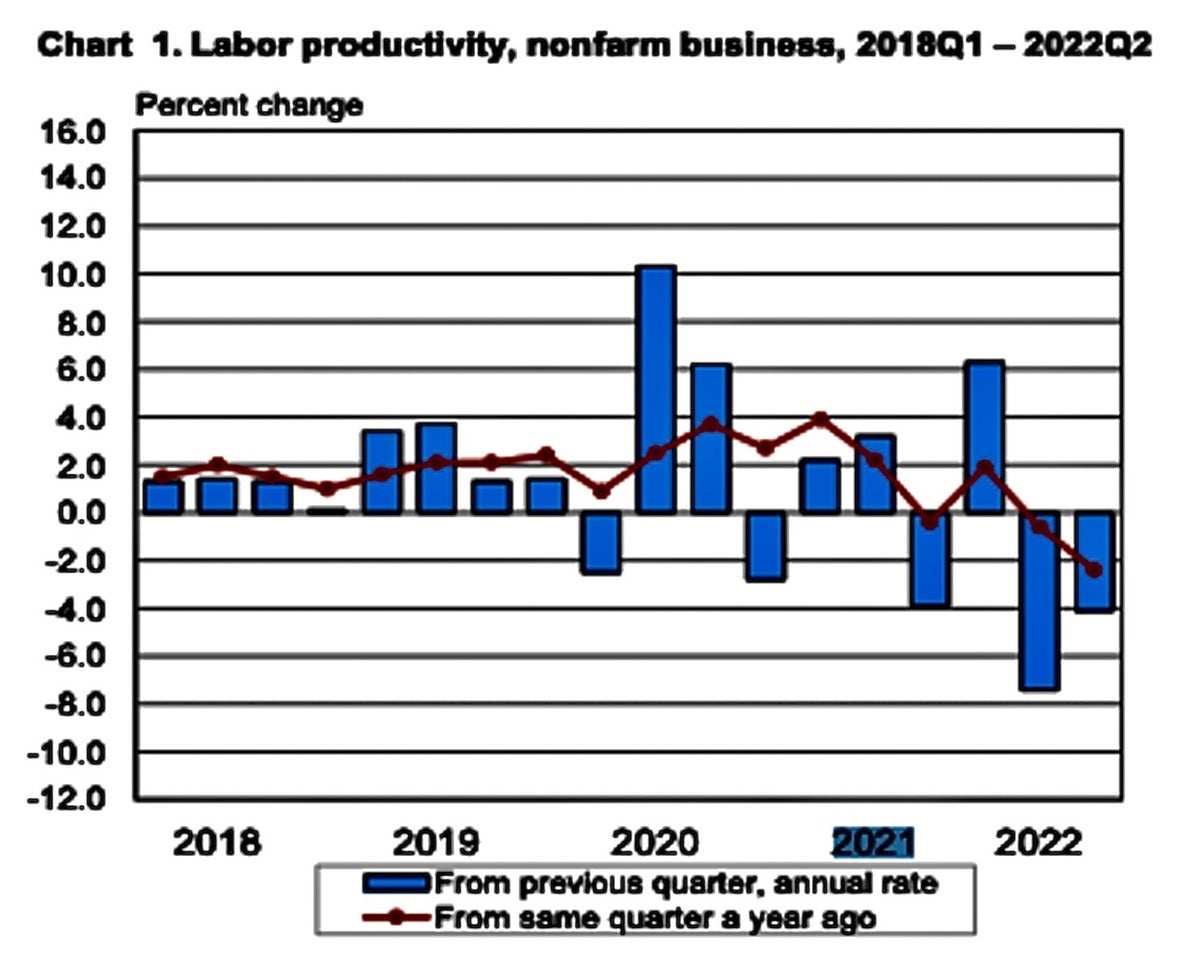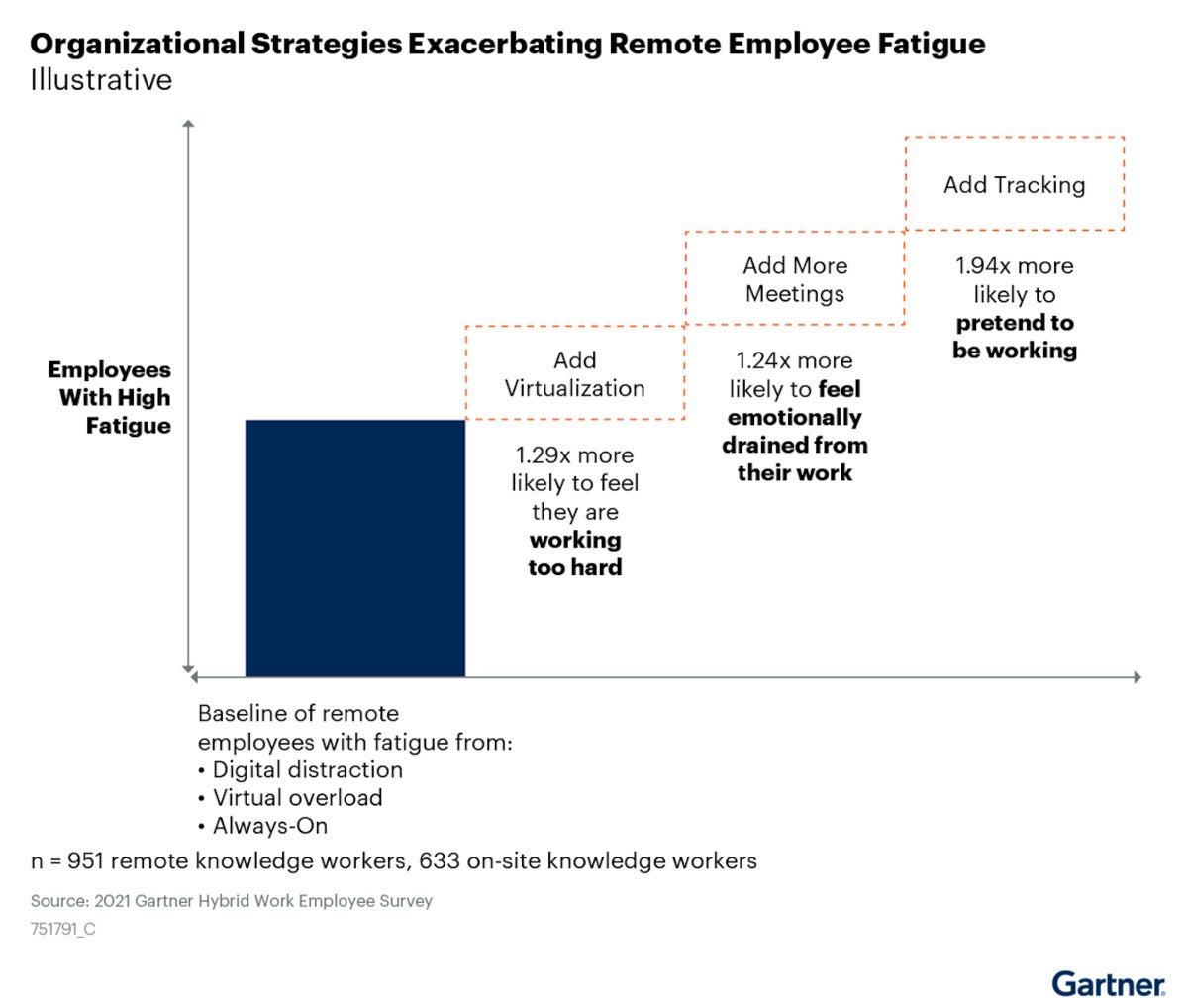































After worker productivity climbed to near-record levels during the first two years of the COVID-19 pandemic and the shift to hybrid and remote work, it fell hard in the first half of 2022 - leaving experts to scratch their heads as to why.
On Thursday, the US Bureau of Labor Statistics released third-quarter data showing business productivity had increased marginally - up just 0.3% from the previous quarter -- and worker output had risen a paltry 2.8%. But compared to the same quarter a year ago, productivity is still down 1.4%, a drop that represents the first instance of three consecutive declines in productivity since 1982.
"The reasons behind it are more technical than just workers are lazier right now," said Sinem Buber, lead economist with ZipRecruiter. "People are not seeing a reason to work harder. They're also burned out."
Generally, during times of recession and low Gross Domestic Product (GDP,) employers cut work hours and layoff employees to address decreasing need for output. But because of an extreme dearth of talent and the Great Resignation, where workers - especially knowledge workers - have been resigning in record numbers, organizations have been reluctant to do layoffs.
Fewer workers also means more pressure on existing employees to maintain or grow output.
 US Bureau of Labor Statistics
US Bureau of Labor Statistics "Businesses have been struggling with labor shortages...and they've seen how hard it is to fill open positions. It can take months and months to find a qualified candidate," Buber said. "Production has also gone down because workers believe regardless of their performance, they'll continue to keep their jobs. That curbs ambition."
The drop in worker productivity coincided with a period when many organizations were requiring employees to return to the office. A recent survey by Resume Builder found that 90% of companies will require employees to get back into the office at least part of the week in 2023. And a fifth of those companies said they would fire workers who refuse.
Caroline Walsh, a vice president of research for Gartner's HR research practice, said there are no definitive answers as to why business worker productivity dropped so precipitously; at this point, employers and economists need to be asking more questions before making any snap decisions on work policies, she said.
While some executives openly argue that forcing workers to return to their cubicles will boost productivity, research does not bear that out, Walsh said.
"We saw a knee-jerk reaction earlier this year. We know CEOs and other executives were worried that work wouldn't get done, but we didn't actually see work not getting done - until organizations began mandating a return to the office," Walsh said.
When organizations mandate a presence in the office, they typically give employees three pieces of information: who goes back; when they go back; and how often they go back. But they often don't tell employees why they need to go back to the office, according to Walsh.
"That's incredibly disempowering and disengaging for employees, particularly for those who've shown over time they can work remotely, which we know has improved feeling of inclusion," Walsh said.
In fact, forcing a return to office or attempting to monitor remote employees with software that tracks their activity usually results in presenteeism - pretending to be working harder by signing into video conferences or sending out more emails, but without any real productive output, Walsh explained.
 Gartner Inc.
Gartner Inc. The only time in-office strategies have had a positive impact on productivity is when organizations require a minimum number of in-person days per year, efforts aimed at periodic team collaboration and corporate culture and community building - both during onsite and offsite events.
Along with calls to return to the workplace, what's also increased over the past year is stress; it's at an all-time high, according to a Gallup workplace report. Fifty-eight percent of employees say they're more stressed, and 48% say they worry more, according to Gallup.
Worker stress and worry has built up over time, with an uncertain economy has just adding to the tension even as employees have had to deal with more change than at any time before.
With the ongoing worker shortage, organizations have had to ask employees to take on more duties - typically without higher compensation. "We were running on adrenaline in the first two years of the pandemic, and now [with] all that extra work we've taken on..., we're seeing this come to a head and that adrenaline and goodwill is no longer sufficient to drive employees forward," Walsh said.
Some experts have speculated that productivity declines are a result of hybrid and remote workers pushing back after they scrambled at unsustainably hard levels in 2000 and 2001. A workforce now empowered by low unemployment - particularly in the technology sector - is enabling "a certain amount of absenteeism on and off the job."
"The problem is that many people who work need supervision. In the new work environment, many workers are left on their own with limited supervision and few metrics or targets for what needs to be accomplished," said Victor Janulaitis, CEO of Utah-based executive consultancy Janco Associates. "Productivity is not the focus of younger workers, they need to have targets for what is to be accomplished. Metrics are key to improved productivity."
In the second quarter of this year, business sector labor productivity decreased 4.1%, according to BLS data. Product and services output decreased 1.4%, even as hours worked increased 2.7%. And in the first quarter of 2022, labor productivity fell 7.4%.
Compare that to the first quarter of 2021, when worker productivity grew by 4.2% in the middle of the pandemic and the fourth quarter of 2021, when productivity increased 6.6% - and output increased 9.1%, according to BLS data. That growth was among the highest in decades, leading some at the time to speculate the nation was experiencing a tech boom not seen since the early 2000s.
When the boom-and-bust cycles are viewed longer term, the annual productivity growth rate since February 2020 is 2.3%, higher than the 1.4% average during the previous business cycle from 2007 to 2019 -- and slightly above the long-term average since 1947 of 2.1%.
Productivity declines are happening at a time when many companies are virtually wringing their collective hands as they try to fill vacancies. So far this year, the US has added 202,800 IT jobs even as more than 4 million US workers have quit their job every month for the past year.
he tech sector, in particular, is seeing the lowest unemployment rate in recent memory -just 2.3%.
At the same time, the Great Resignation has een an exodus of people from the workforce for a myriad of reasons. Many re-evaluated their work-life balance and career choices; others simply left for better pay and benefits. Knowledge workers want flexible conditions, including continuing hybrid/remote work options and fewer work days. Employers have responded by frantically deploying new strategies to fill the talent void, including removing college degree requirements from job listings and hiring outside of traditional geographies.
ZipRecuiter's Buber sees the Great Resignation as the primary driver of productivity declines among knowledge workers, pointing to the exodus of veteran employees that required organizations to train new hires. Beyond that, rolling out return-to-office mandates only made matters worse and accelerated the mass workplace exodus. Thought many companies moved to reverse course, some damage had already been done.
"I can quit my job if I'm called back to office," Buber said. "Quit rates make workers less productive as they begin new jobs."
Another issue affecting productivity, Buber argued, is motivation. When new employees are hired, they often come in with pay and benefits equal to or better than veteran employees. Even as companies have raised wages for their workforce, it's often across the board, ignoring seniority.
"So, the link between hard work and raises is broken," Buber said.
Starting with the uptick in the third quarter, however, Buber does expect productivity to return to levels seen in the first two years of the pandemic as the Great Resignation slows and employees settle into a new normal.
"Productivity is a very difficult number to predict; it's hard to see what's coming in the next quarter," she said. "But over the next couple of years, once the quit rates go back to normal levels and we have more tenured people with institutional knowledge..., when the new hires have learned the job..., we will see the productivity levels go back up."
 Tags quentes :
Indústria de Tecnologia
Vagas em TI
Carreiras
Indústria
Salários
Tags quentes :
Indústria de Tecnologia
Vagas em TI
Carreiras
Indústria
Salários